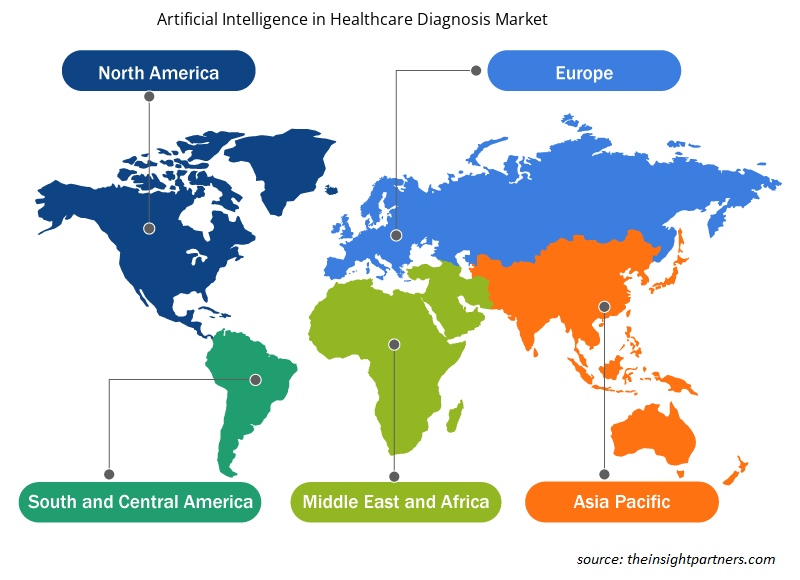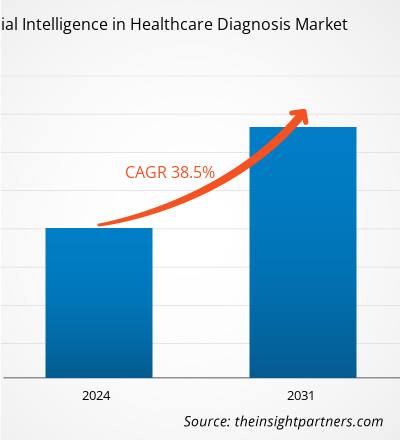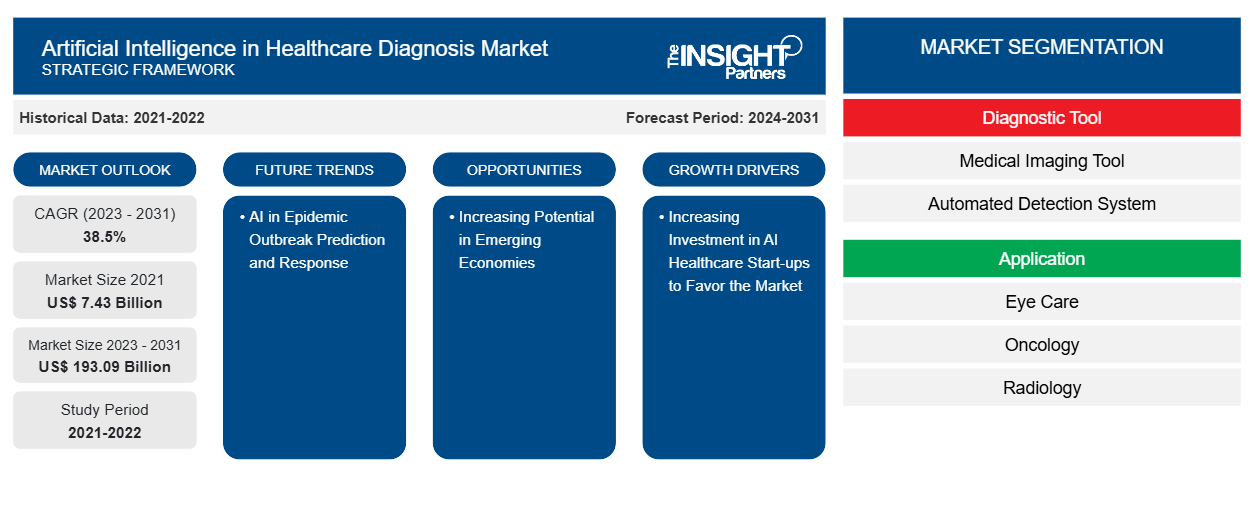تم تقدير سوق الذكاء الاصطناعي في تشخيص الرعاية الصحية بنحو 7.43 مليار دولار أمريكي في عام 2021 وxx مليار دولار أمريكي في عام 2023. ومن المتوقع أن يصل إلى 193.09 مليار دولار أمريكي بحلول عام 2031 ويسجل معدل نمو سنوي مركب بنسبة 38.5٪ حتى عام 2031. ومن المرجح أن تظل حلول التصوير المدعومة بالذكاء الاصطناعي والمراقبة عن بعد والطب عن بعد والتحليلات التنبؤية والكشف المبكر هي الذكاء الاصطناعي الرئيسي في اتجاهات سوق تشخيص الرعاية الصحية.
تحليل سوق الذكاء الاصطناعي في تشخيص الرعاية الصحية
ومن المتوقع أن تؤدي العوامل الرئيسية التي تحرك السوق مثل التبني المتزايد للذكاء الاصطناعي في تشخيص الأمراض وتحديدها وزيادة الاستثمار في الشركات الناشئة في مجال الرعاية الصحية القائمة على الذكاء الاصطناعي إلى دفع نمو السوق. ويؤدي دمج الذكاء الاصطناعي في الإجراءات التشخيصية إلى تحويل صناعة التشخيص ورعاية المرضى. على سبيل المثال، في أكتوبر 2023، تعاونت شركة فيليبس مع شركة Quilbim الإسبانية لتوفير أدوات التصوير وإعداد التقارير بالذكاء الاصطناعي لدعم فحوصات البروستاتا بالرنين المغناطيسي.
ومع ذلك، فإن الافتقار إلى القوى العاملة الماهرة في مجال الذكاء الاصطناعي والمبادئ التوجيهية التنظيمية الغامضة للبرمجيات الطبية تعيق نمو السوق.
نظرة عامة على سوق الذكاء الاصطناعي في تشخيص الرعاية الصحية
تم تقسيم سوق الذكاء الاصطناعي العالمي في تشخيص الرعاية الصحية حسب المنطقة إلى أمريكا الشمالية وأوروبا وآسيا والمحيط الهادئ والشرق الأوسط وأفريقيا وأمريكا الجنوبية والوسطى. ومن المتوقع نمو السوق في هذه المنطقة بسبب عوامل مثل الحاجة المتزايدة إلى خفض تكاليف الرعاية الصحية وأهمية البيانات الضخمة في الرعاية الصحية، وهي بعض العوامل التي تدفع النمو. بالإضافة إلى ذلك، زيادة قابلية تطبيق الأدوات القائمة على الذكاء الاصطناعي في الرعاية الطبية وارتفاع الاستثمارات الرأسمالية. بالإضافة إلى ذلك، فإن التبني المتزايد للذكاء الاصطناعي في تشخيص الأمراض وتحديدها وزيادة الاستثمار في الشركات الناشئة في مجال الرعاية الصحية القائمة على الذكاء الاصطناعي يؤدي إلى نمو السوق خلال فترة التوقعات.
قم بتخصيص هذا التقرير ليناسب متطلباتك
ستحصل على تخصيص لأي تقرير - مجانًا - بما في ذلك أجزاء من هذا التقرير، أو تحليل على مستوى الدولة، وحزمة بيانات Excel، بالإضافة إلى الاستفادة من العروض والخصومات الرائعة للشركات الناشئة والجامعات
-
احصل على أهم اتجاهات السوق الرئيسية لهذا التقرير.ستتضمن هذه العينة المجانية تحليلاً للبيانات، بدءًا من اتجاهات السوق وحتى التقديرات والتوقعات.
الذكاء الاصطناعي في تشخيص الرعاية الصحية: العوامل المحركة والفرص
زيادة عدد إطلاقات المنتجات لصالح السوق.
يعد الذكاء الاصطناعي في مجال الرعاية الصحية أحد أهم التطورات التكنولوجية حتى الآن. تعمل الشركات الناشئة في مجال الرعاية الصحية على تطوير حلول تشخيصية وعلاجية تعتمد على الذكاء الاصطناعي، وهي العوامل الرئيسية المسؤولة عن نمو السوق في فترة الدراسة. في مايو 2023، أطلقت Lumibird Medical منصة C.DIAG، وهي منصة مساعدة لتشخيص جفاف العين تستخدم خوارزميات الذكاء الاصطناعي. وبالمثل، في أبريل 2024، أطلقت شركة جنرال إلكتريك برنامج Caption AI القائم على الذكاء الاصطناعي لإجراء تقييمات قلبية سريعة في نقطة الرعاية على Vscan Air SL.
زيادة الإمكانات في الاقتصادات الناشئة – فرصة في مجال الذكاء الاصطناعي في سوق تشخيص الرعاية الصحية
كما يمكن للذكاء الاصطناعي أن يحسن القيود الناجمة عن ضعف البنية الأساسية في الأسواق الناشئة من خلال توفير البدائل والحلول الفعالة من حيث التكلفة لتقديم الخدمات لأولئك الذين يحتاجون إليها أكثر من غيرهم، بما في ذلك المجتمعات النائية. وباستخدام التغطية الواسعة النطاق لشبكات الهاتف المحمول، يتم استخدام الذكاء الاصطناعي في الطب عن بعد للتشخيص المبكر للأمراض، مما يوفر تكلفة الحفاظ على شبكة واسعة من العاملين الصحيين المجتمعيين. إن فحص السرطان وعلاجه هو المكان الذي يوفر فيه الذكاء الاصطناعي نطاقًا ملحوظًا للتدخلات المستهدفة واسعة النطاق. تشهد الهند انتشارًا لأكثر من مليون حالة جديدة من السرطان سنويًا. ومن المرجح أن يزداد هذا العدد، بسبب زيادة عدد السكان الهنود المسنين وتغييرات نمط الحياة. مقابل حدوث أكثر من مليون حالة سرطان جديدة كل عام، لا يوجد في الهند سوى 2000 أخصائي علم أمراض من ذوي الخبرة في علم الأورام وأقل من 500 أخصائي علم أمراض يمكن اعتبارهم خبراء في علم الأورام.
وبالتالي، فإن دمج الذكاء الاصطناعي في حلول التشخيص يمكن أن يؤدي إلى بناء أنظمة رعاية صحية أكثر مرونة واستدامة في الدول الناشئة.
تقرير تحليل تجزئة سوق الذكاء الاصطناعي في تشخيص الرعاية الصحية
القطاعات الرئيسية التي ساهمت في اشتقاق تحليل سوق الذكاء الاصطناعي في تشخيص الرعاية الصحية هي الخدمات والتطبيقات.
- بناءً على أدوات التشخيص، ينقسم الذكاء الاصطناعي في سوق تشخيص الرعاية الصحية إلى أدوات التصوير الطبي وأنظمة الكشف الآلي وغيرها. احتل قطاع أدوات التصوير الطبي حصة سوقية أكبر في عام 2023. ومع ذلك، من المتوقع أن يسجل نظام الكشف الآلي أعلى معدل نمو سنوي مركب في السوق خلال فترة التنبؤ.
- تم تقسيم السوق حسب التطبيق إلى رعاية العيون والأورام والأشعة وأمراض القلب والأوعية الدموية وغيرها. احتل قطاع الأورام الحصة الأكبر من السوق في عام 2023. ومع ذلك، من المتوقع أن يشهد قطاع الأشعة أسرع معدل نمو في السوق خلال فترة التوقعات.
- من حيث المستخدم النهائي، تم تقسيم الذكاء الاصطناعي في سوق تشخيص الرعاية الصحية إلى المستشفيات والعيادات والمختبرات التشخيصية والرعاية المنزلية. احتل قطاع المستشفيات والعيادات الحصة الأكبر من السوق، في حين من المتوقع أن يشهد قطاع المختبرات التشخيصية أسرع معدل نمو في السوق خلال فترة التوقعات.
- بناءً على الخدمة، تم تقسيم سوق الذكاء الاصطناعي في تشخيص الرعاية الصحية إلى الاستشارة عن بعد والمراقبة عن بعد وخدمات أخرى. احتل قطاع الاستشارة عن بعد الحصة الأكبر من السوق، في حين من المتوقع أن يسجل قطاع المراقبة عن بعد أعلى معدل نمو سنوي مركب في السوق خلال فترة التوقعات.
تحليل حصة سوق الذكاء الاصطناعي في تشخيص الرعاية الصحية حسب المنطقة الجغرافية
ينقسم النطاق الجغرافي لتقرير سوق الذكاء الاصطناعي في تشخيص الرعاية الصحية بشكل أساسي إلى خمس مناطق: أمريكا الشمالية، ومنطقة آسيا والمحيط الهادئ، وأوروبا، والشرق الأوسط وأفريقيا، وأمريكا الجنوبية/أمريكا الجنوبية والوسطى.
أمريكا الشمالية هي أكبر سوق للذكاء الاصطناعي في سوق تشخيص الرعاية الصحية، حيث تمتلك الولايات المتحدة أكبر حصة سوقية، تليها كندا. إن نمو السوق في الولايات المتحدة مدفوع بعوامل مثل الحاجة إلى خفض تكاليف الرعاية الصحية، والأهمية المتزايدة للبيانات الضخمة في الرعاية الصحية، والاستثمار الرأسمالي المتزايد يساهم في الطلب على الذكاء الاصطناعي في تشخيص الرعاية الصحية. وبالمثل، في كندا، تساهم المبادرات الحكومية المتزايدة لتطبيق التقنيات القائمة على الذكاء الاصطناعي في جميع أنحاء البلاد في نمو السوق.
تعد منطقة آسيا والمحيط الهادئ أسرع الأسواق نموًا للذكاء الاصطناعي في تشخيص الرعاية الصحية على المستوى العالمي. يتم تحليل المنطقة بناءً على الصين والهند واليابان وأستراليا وكوريا الجنوبية وبقية منطقة آسيا والمحيط الهادئ. ومن المتوقع أن تتمتع المنطقة بالعديد من فرص النمو لنمو السوق بسبب نقص المتخصصين في الرعاية الصحية، وزيادة انتشار الأمراض المزمنة، وزيادة الاستثمار في الشركات الناشئة وتحسين البنية التحتية للرعاية الصحية في المنطقة.
رؤى إقليمية حول سوق الذكاء الاصطناعي في تشخيص الرعاية الصحية
لقد قام المحللون في Insight Partners بشرح الاتجاهات والعوامل الإقليمية المؤثرة على سوق الذكاء الاصطناعي في تشخيص الرعاية الصحية طوال فترة التوقعات بشكل شامل. يناقش هذا القسم أيضًا قطاعات سوق الذكاء الاصطناعي في تشخيص الرعاية الصحية والجغرافيا في جميع أنحاء أمريكا الشمالية وأوروبا ومنطقة آسيا والمحيط الهادئ والشرق الأوسط وأفريقيا وأمريكا الجنوبية والوسطى.

- احصل على البيانات الإقليمية المحددة لسوق الذكاء الاصطناعي في تشخيص الرعاية الصحية
نطاق تقرير سوق الذكاء الاصطناعي في تشخيص الرعاية الصحية
| سمة التقرير | تفاصيل |
|---|---|
| حجم السوق في عام 2021 | 7.43 مليار دولار أمريكي |
| حجم السوق بحلول عام 2031 | 193.09 مليار دولار أمريكي |
| معدل النمو السنوي المركب العالمي (2023 - 2031) | 38.5% |
| البيانات التاريخية | 2021-2022 |
| فترة التنبؤ | 2024-2031 |
| القطاعات المغطاة |
بواسطة أداة التشخيص
|
| المناطق والدول المغطاة |
أمريكا الشمالية
|
| قادة السوق وملفات تعريف الشركات الرئيسية |
|
كثافة اللاعبين في سوق الذكاء الاصطناعي في تشخيص الرعاية الصحية: فهم تأثيره على ديناميكيات الأعمال
يشهد سوق الذكاء الاصطناعي في تشخيص الرعاية الصحية نموًا سريعًا، مدفوعًا بالطلب المتزايد من المستخدم النهائي بسبب عوامل مثل تفضيلات المستهلكين المتطورة والتقدم التكنولوجي والوعي الأكبر بفوائد المنتج. ومع ارتفاع الطلب، تعمل الشركات على توسيع عروضها والابتكار لتلبية احتياجات المستهلكين والاستفادة من الاتجاهات الناشئة، مما يؤدي إلى زيادة نمو السوق.
تشير كثافة اللاعبين في السوق إلى توزيع الشركات أو المؤسسات العاملة في سوق أو صناعة معينة. وهي تشير إلى عدد المنافسين (اللاعبين في السوق) الموجودين في مساحة سوق معينة نسبة إلى حجمها أو قيمتها السوقية الإجمالية.
الشركات الرئيسية العاملة في سوق الذكاء الاصطناعي في تشخيص الرعاية الصحية هي:
- مايكروسوفت،
- شركة كونيكليك فيليبس إن في،
- شركة إنتل،
- شركة جنرال الكتريك
- شركة ألفابيت،
- شركة NVIDIA،
إخلاء المسؤولية : الشركات المذكورة أعلاه ليست مرتبة بأي ترتيب معين.

- احصل على نظرة عامة على أهم اللاعبين الرئيسيين في سوق تشخيص الذكاء الاصطناعي في الرعاية الصحية
أخبار سوق الذكاء الاصطناعي في تشخيص الرعاية الصحية والتطورات الأخيرة
يتم تقييم سوق الذكاء الاصطناعي في تشخيص الرعاية الصحية من خلال جمع البيانات النوعية والكمية بعد البحث الأولي والثانوي، والتي تتضمن منشورات الشركات المهمة وبيانات الجمعيات وقواعد البيانات. فيما يلي قائمة بالتطورات في سوق الذكاء الاصطناعي في تشخيص الرعاية الصحية والاستراتيجيات:
- في مايو 2023، أطلقت شركة Digital Diagnostics نظام التشخيص LumineticsCore Al في المنطقة الجنوبية الشرقية من الولايات المتحدة. LumineticsCore هو نظام تشخيصي مستقل معتمد من إدارة الغذاء والدواء الأمريكية (المصدر: بيان صحفي للشركة)
- في ديسمبر 2021، أطلقت شركة F. Hoffmann-La Roche Ltd خوارزميات علم الأمراض الرقمية القائمة على الذكاء الاصطناعي لمساعدة علماء الأمراض في تقييم علامات سرطان الثدي، Ki-67 وER وPR. (المصدر: بيان صحفي للشركة)
تقرير سوق الذكاء الاصطناعي في تشخيص الرعاية الصحية: التغطية والنتائج المتوقعة
يقدم تقرير "حجم سوق الذكاء الاصطناعي في تشخيص الرعاية الصحية والتوقعات (2021-2031)" تحليلاً مفصلاً للسوق يغطي المجالات التالية:
- حجم السوق والتوقعات على المستويات العالمية والإقليمية والوطنية لجميع قطاعات السوق الرئيسية التي يغطيها النطاق
- ديناميكيات السوق مثل المحركات والقيود والفرص الرئيسية
- الاتجاهات المستقبلية الرئيسية
- تحليل مفصل لقوى PEST/Porter الخمس وSWOT
- تحليل السوق العالمي والإقليمي الذي يغطي اتجاهات السوق الرئيسية واللاعبين الرئيسيين واللوائح والتطورات الأخيرة في السوق
- تحليل المشهد الصناعي والمنافسة الذي يغطي تركيز السوق، وتحليل خريطة الحرارة، واللاعبين البارزين، والتطورات الأخيرة
- ملفات تعريف الشركة التفصيلية
- التحليل التاريخي (سنتان)، سنة الأساس، التوقعات (7 سنوات) مع معدل النمو السنوي المركب
- تحليل PEST و SWOT
- حجم السوق والقيمة / الحجم - عالمي، إقليمي، بلد
- الصناعة والمنافسة
- مجموعة بيانات إكسل
التقارير الحديثة
تقارير ذات صلة
شهادات العملاء
سبب الشراء
- اتخاذ قرارات مدروسة
- فهم ديناميكيات السوق
- تحليل المنافسة
- رؤى العملاء
- توقعات السوق
- تخفيف المخاطر
- التخطيط الاستراتيجي
- مبررات الاستثمار
- تحديد الأسواق الناشئة
- تحسين استراتيجيات التسويق
- تعزيز الكفاءة التشغيلية
- مواكبة التوجهات التنظيمية























 احصل على عينة مجانية ل - الذكاء الاصطناعي في سوق تشخيص الرعاية الصحية
احصل على عينة مجانية ل - الذكاء الاصطناعي في سوق تشخيص الرعاية الصحية